This year, Teaneck saw record turnout at the polls. One member of the Board of Education received more votes than any local office holder in the history of the municipality.
Resident Tom Abbott, made a comment here, providing a link to details on his website, where he broke down the voter numbers. And one thing stuck out to to me. Three of the districts, at first glance, seemed to have far fewer registered voters than others.
Districts should have, roughly, an even number of registered voters. But as I started to look into the issue, I found that Teaneck, compared to its neighbors also has far fewer districts.
Fact: Teaneck has the highest number of registered voters for any Municipality in Bergen County.
We do NOT have the greatest number of Election Districts.
Why not?
Hackensack, with over 6,000 fewer registered voters than Teaneck, has 25 election districts, compared to our 23.
Fair Lawn, with over 5,000 fewer registered voters than Teaneck, has the same number of districts as us.
When it comes to the average number of voters per district, Teaneck packs more in than anyone.
And when you look at our districts, the numbers of registered voters they contain, are all over the place. Despite an average of 1,258 voters, some districts (e.g. 12) have 1,776 while others (e.g. 16) have a mere 788.
Why does any of this matter?
There are several reasons.
There is a County Committee pursuant to Title 19, Section 19:5-3
Membership and organization of county committees; vacancies; certification of unit of representation and number of election districts.
NJ Rev Stat § 19:5-3 (2013)
As you can see from the By-Laws of the Bergen County Democratic Committee:
The County Committee shall be composed of one male and one female member elected at the Biannual Primary Election by the Democratic voters of each election district of the County pursuant to law.
– Section 1. ELECTED MEMBERSHIP
and the By-Laws of the Bergen County Republican Committee:
Section 1. The membership of this organization shall be composed of members of the Bergen County Republican County Committee who have been duly elected or appointed pursuant to Title 19.
– Art. III, Section 1. Membership
On the local level, there is a municipal committee for each party, comprised of one male and one female from each election district.
The members of the municipal committees of political parties shall consist of the elected members of the county committee resident in the respective municipalities
NJ Rev Stat § 19:5-2 (2013)
So, as an example, while Teaneck has 2.25x as many registered voters in District 12 as it does in District 16, both get two representatives. And while Hackensack has over 6,000 FEWER registered voters than Teaneck, they get MORE representation at the County Committee because they have more election districts.
What is the right number of districts and why does it matter?
When one election district has 2.2x as many registered voters, the lines are 2.2x as long. The volunteers are asked to work 2.2x as hard. The number of machines / ballots and equipment needed is in part based on the number of expected voters.
In Title 19, Section 19:4-13, the relevant numbers to look for are election districts with more than 750 or less than 250 votes cast in any two consecutive general elections.
19:4-13. Readjustment of boundaries for correct number of voters
When in any two consecutive general elections in an election district more than 750 or less than 250 votes shall have been cast, the county board shall readjust the boundary lines of such election district and other election districts necessary to effect changes so that none of the election districts affected shall have more than 750 registered voters, and for this purpose shall have power to consolidate any number of districts and subdivide the same.
NJ Rev Stat § 19:4-13 (2016)
How many Teaneck Districts had more than 750 votes cast in two consecutive general elections?
Here’s the breakdown:
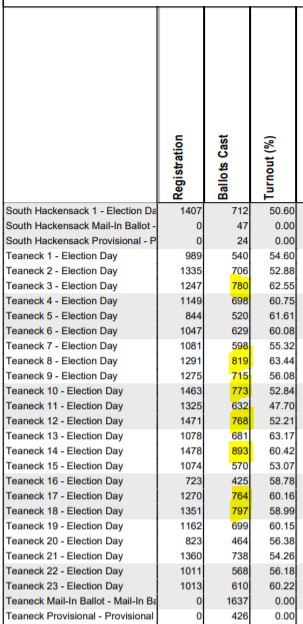
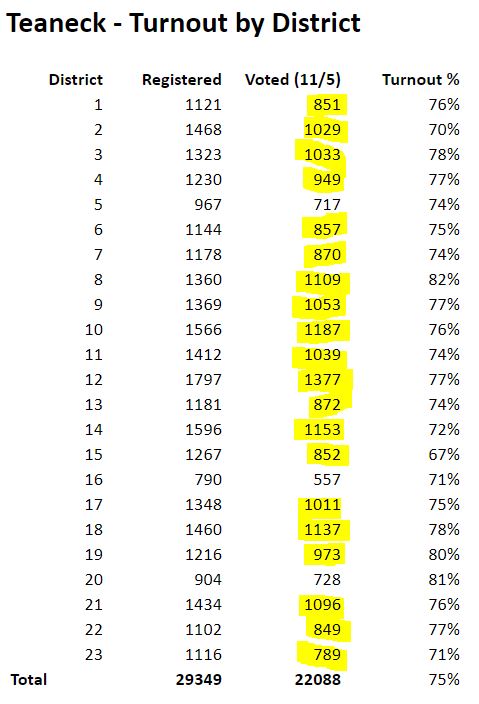
We have 7 election districts that have consecutively had more than 750 voters, and all but three did, this year.
Will Redistricting Change Council / BOE elections?
No. Because our elections are “at-large”, meaning that you vote for members of Town Council and Board of Education regardless of where you live, redistricting will have no effect on our elections. Whoever receives the most votes will still win.
What is the process for redistricting and how many districts will we have?
That is what I intend to look at. On Tuesday, I will present the information above to the Council and ask that we create a task force to look at our election districts. We should have clean and clear districts, with roughly the same number of voters in each.
To bring down the average number of voters at the polls to the maximum permitted (750), would require an additional 7 districts.
We currently average over 1,250 registered voters in each of our 23 districts. Bringing that number down to 750 would mean adding 16 districts.
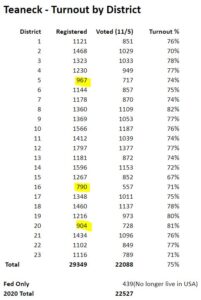
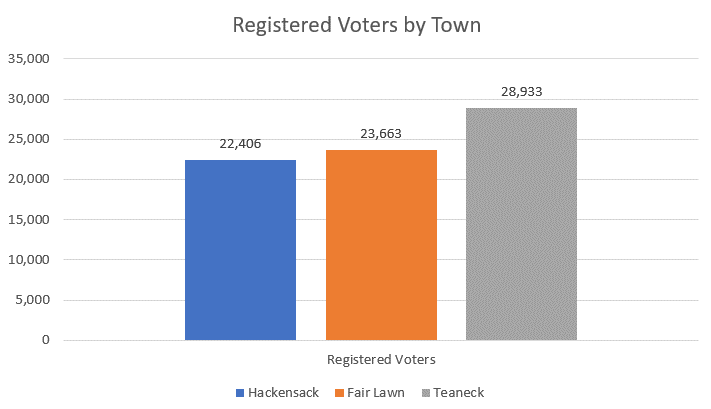
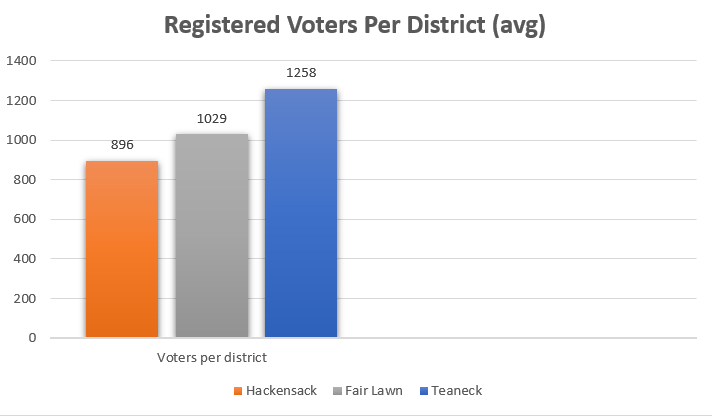
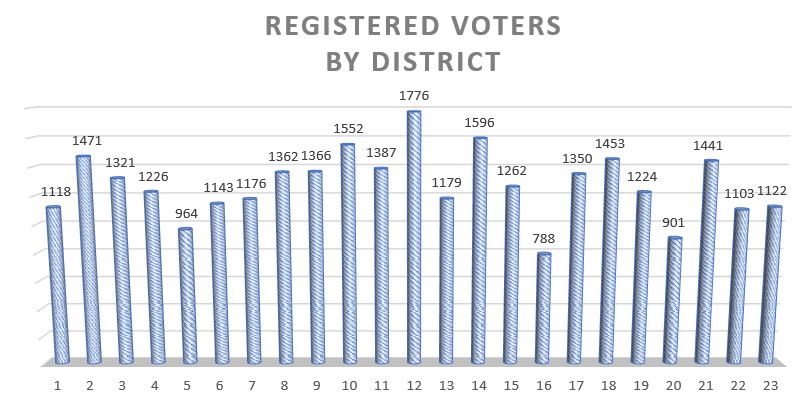
This is not a new situation. It was worse before the 2012 redistricting. In 2011, Teaneck had roughly 20% more registered voters and 25% more residents than Fairlawn and two fewer election districts. Adding two more in 2012 made it better but still far from equitable.
Unlike congressional and legislative districts which are based on population, the same requirement does not apply to local voting districts. They are to a large extent designed to make it reasonably easy for voters to get to their polling places and thus are often created around local geographic boundaries and with consideration of potential polling place locations. This and shifting populations can create variances between neighboring districts.
The voting districts are created by the County Board of Elections which consists of 3 Democrats and 3 Republicans. Though bipartisan by design it is still made up of politicians. I have always suspected the political nature of the board has something to do with Teaneck being short changed when it comes to number of districts and thus representation in the party committees.
It’s also worth noting that the provisions of “19:4-13. Readjustment of boundaries for correct number of voters” does not actually appear to be relevant because it refers to “two consecutive general elections.” 2018 and 2020 are not consecutive general elections. There is a general election every year. No district reached 750 votes cast in 2017 or 2019.
Also, my Teaneck – Turnout by District chart was attached to a post that made it clear that it only counted mail in ballots received by Election Day, November 5 – about 1500 additional ballots were cast. The registration data came from Bergen County, but it omitted Teaneck voters who no longer reside in the United States and can only vote in federal elections. From past history, I know others may have been left out as well.
That’s a fair point about the consecutive elections.
The prior statute (Section 19:4-12) states, in relevant part: “each district in which two voting machines or five electronic system voting devices are to be used shall contain, as nearly as is practicable, 1,000 voters”, so our districts are still above average and have some highs and lows.
I would still maintain that this is something that should be looked at.